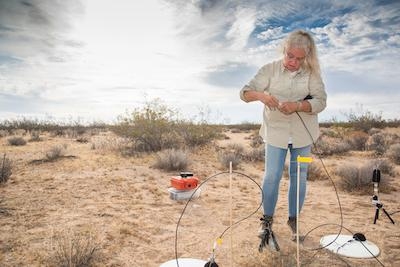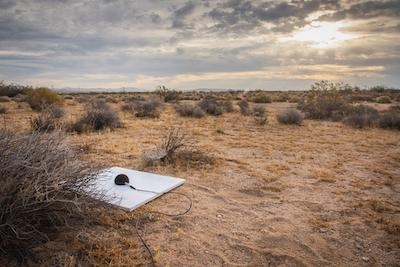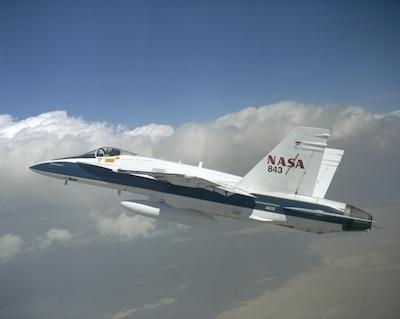Will Be Used To Measure 'Sonic Thumps' Produced By Quiet Supersonic X-59
NASA has successfully tested a large microphone array in California’s Mojave Desert as part of a flight series in preparation for the agency’s quiet supersonic X-plane, the X-59.

Flying at speeds faster than Mach 1, the speed of sound, typically produces a loud sonic boom heard on the ground below. NASA’s X-59 Quiet SuperSonic Technology X-plane, or X-59 QueSST for short, will fly over select communities around the U.S. to demonstrate the ability to reduce that sonic boom to a quiet thump. The data from these flights will be turned over to the Federal Aviation Administration to possibly establish new sound-based rules for supersonic flight over land. This could open the door to future faster-than-sound commercial cargo and passenger air travel.
Before these community overflights take place, however, the X-59 will first undergo an acoustic validation phase, during which NASA will deploy an approximately 30-mile-long array of specially-configured microphones to measure the X-59’s thumps, to verify that they are as quiet as predicted.
The recently-completed Carpet Determination In Entirety Measurements flight series, or CarpetDIEM, was NASA’s “first practice” for the X-59’s acoustic validation flights.

“The X-59 is designed to have quiet sonic booms that won’t be disturbing to the people, but first we actually have to go out and prove it,” explained Ed Haering, NASA’s principal investigator for CarpetDIEM. “NASA will do that by flying the aircraft and taking real measurements on the ground before we eventually fly it over communities, to make sure that it is as quiet as it should be.”
NASA will collect these sound measurements using a microphone array on the ground that covers the entire width where the X-59’s quiet sonic thumps can be heard – a measurement area known as the “carpet.” The goal of CarpetDIEM was to practice deploying a large-scale microphone array, and gain valuable lessons on the array’s ideal configuration, instrumentation, and logistics.
The test microphone array for this flight series was deployed along an area of the Mojave Desert near NASA’s Armstrong Flight Research Center in Edwards, California, from which NASA flew an F/A-18 aircraft to produce sonic booms under the designated supersonic corridor, which runs from Nevada toward Edwards.
“We chose this area of the Mojave Desert because it’s a nice, wide area under our high-altitude supersonic corridor, where we are able to fly our F/A-18s at supersonic speeds routinely,” said Haering. “Here we can learn how to best deploy a sensor array of this magnitude, and the logistics of getting the hardware out here, using it for testing, and getting it back, and logging the data.”
The array featured high-fidelity microphones, capable of measuring 50,000 samples per second, giving researchers the ability to obtain accurate sound data and assess the loudness of the sonic booms, just as they will measure the quiet sonic thumps from the X-59.
The flight series included engineers, researchers, and managers from NASA Armstrong and NASA’s Langley Research Center in Hampton, Virginia, as well as participants from the Volpe National Transportation Systems Center in Cambridge, Massachusetts, and graduate students and professors from Brigham Young University (BYU) in Provo, Utah. Participants were spread out to cover as much of the wide microphone array as possible.
“We have a series of microphones set up, and the various sites have different configurations,” explained Juliet Page, a physical scientist with Volpe. “We have microphones oriented in different configurations, including inverted, vertical, horizontal, some with different wind screens, and we’re evaluating the acoustic performance and the difference between the different configurations in preparation of the X-59.”

“It’s cool to come out in the desert and just do all these measurements and just kind of geek out with this technology,” Page added.
The data will now undergo analysis in preparation of furthering the technology for future flight tests.
CarpetDIEM was flown under NASA’s Commercial Supersonic Technology project, which supports X-59’s Low-Boom Flight Demonstration mission through conducting supersonic flight research and technology development.
“The Commercial Supersonic Technology project is responsible for measuring and validating the level of the acoustic signature from X-59 prior to our planned community overflight testing. We want to be sure we are fully prepared for that challenge,” said CST project manager Lori Ozoroski. “This joint effort between NASA, Volpe, and BYU involved a number of early mornings and long, hot days to set-up and record sonic booms generated by a NASA F/A-18. Lessons learned from this test will next be applied to the second phase of the CarpetDIEM testing, currently planned for summer 2020.”
The CST project seeks to develop the tools and technologies needed to overcome the technical barriers to practical commercial supersonic flight. If you ask Ed Haering, who has spent 25 of his 35-year-career at NASA researching sonic booms, overcoming barriers is what it’s all about.
“It’s been 70 years since Chuck Yeager broke the sound barrier,” explained Haering, standing under the same skies where, in 1947, Yeager became the first pilot to fly faster than the speed of sound.
“Now we’re trying to fix it.”
(Images provided with NASA Aeronautics news release)
 ANN's Daily Aero-Term (04.25.24): Airport Rotating Beacon
ANN's Daily Aero-Term (04.25.24): Airport Rotating Beacon ANN's Daily Aero-Linx (04.25.24)
ANN's Daily Aero-Linx (04.25.24) Klyde Morris (04.22.24)
Klyde Morris (04.22.24) Airborne 04.24.24: INTEGRAL E, Elixir USA, M700 RVSM
Airborne 04.24.24: INTEGRAL E, Elixir USA, M700 RVSM Airborne 04.22.24: Rotor X Worsens, Airport Fees 4 FNB?, USMC Drone Pilot
Airborne 04.22.24: Rotor X Worsens, Airport Fees 4 FNB?, USMC Drone Pilot





